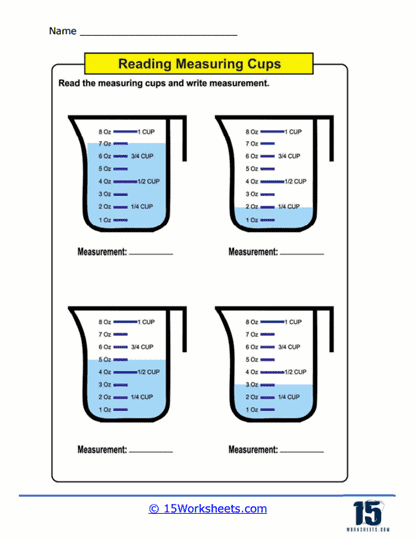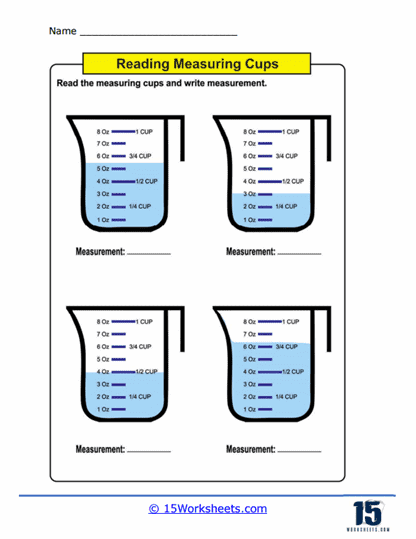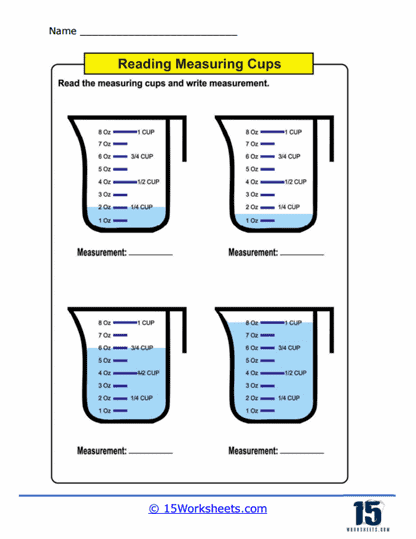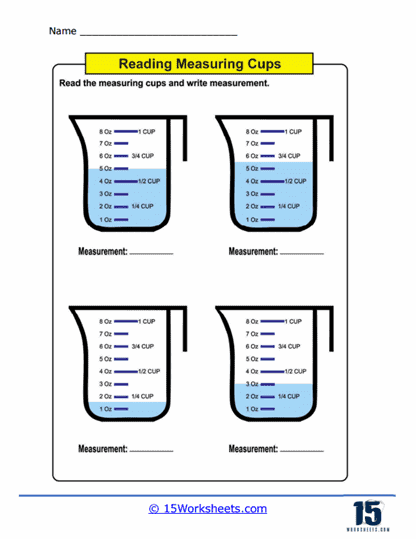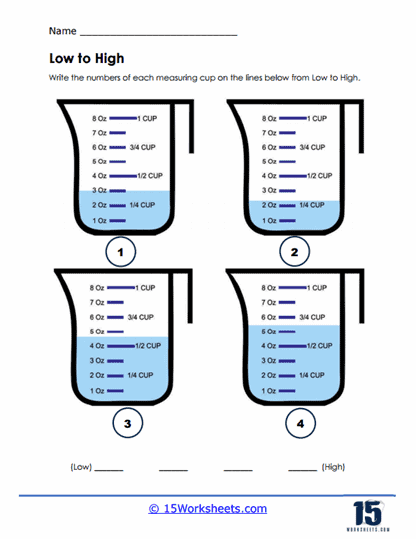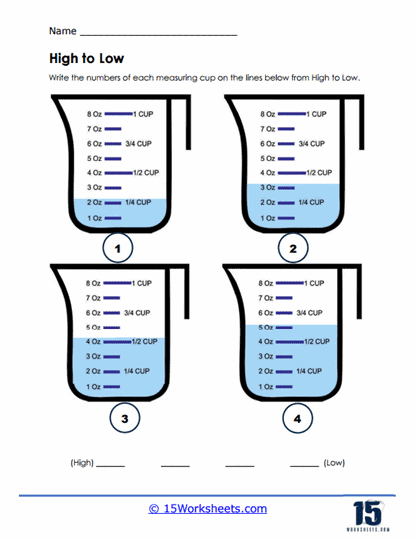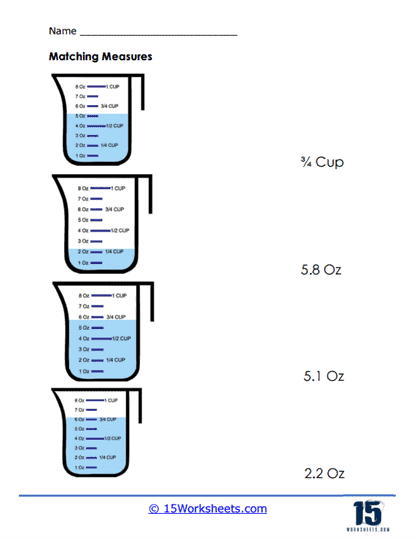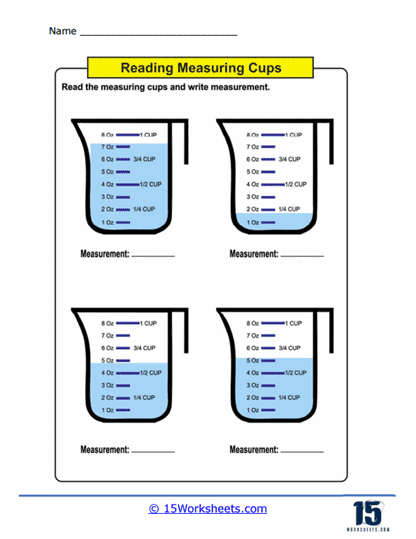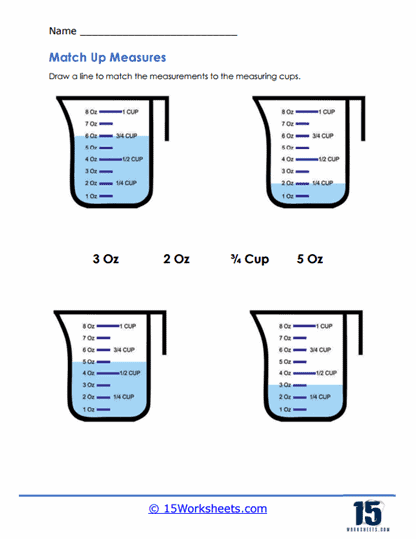Measuring Cups Worksheets
About These 15 Worksheets
These worksheets are designed to teach and reinforce concepts related to measuring volume in cooking, baking, science experiments, and other practical applications. These worksheets are widely used in educational settings such as elementary schools, home schooling environments, and even in adult education classes where understanding measurements is crucial. The primary goal of these worksheets is to help students develop a solid foundation in handling measurements, specifically understanding and using measuring cups, which are essential tools in various fields.
One of the core exercises you’ll find on Measuring Cups Worksheets involves identifying different sizes of measuring cups. Worksheets may display images of 1 cup, 1/2 cup, 1/3 cup, and 1/4 cup measures, and ask students to match them with their corresponding volume labels. This exercise helps students visually distinguish between different measuring cups and reinforces their understanding of fractional divisions and their practical applications.
Another common type of exercise is the conversion task, where students are required to convert measurements from one unit to another, such as converting tablespoons to cups or liters to cups. These activities not only reinforce the concept of equivalency within volume measurements but also integrate a bit of mathematical skills, as students often need to multiply or divide to find the correct answers. This type of exercise is crucial for developing a flexible understanding of volume, enabling students to adapt recipes or scale experiments as needed.
Filling exercises are also popular on Measuring Cups Worksheets. In these activities, students may be presented with illustrations of measuring cups at various levels of fullness. They are asked to write the amount of liquid each cup contains, often needing to estimate based on markers that are shown on the side of the cup. This type of exercise enhances students’ skills in estimating and reading measurements accurately, which is a vital skill in both the kitchen and the laboratory.
Practical application exercises on these worksheets usually involve scenarios where students must decide how many measuring cups of a certain size are needed to achieve a desired total volume. For example, a problem might state that a recipe requires 3 1/2 cups of flour, and students must figure out how many 1/2 cups are needed to meet this requirement. These real-world applications make the mathematical concepts more tangible and help students understand the relevance of accurate measurement in everyday life.
Some of the worksheets incorporate comparative exercises where students are shown two different measurements and must determine which is greater or if they are the same. These exercises might include visual comparisons of liquid in measuring cups or numerical comparisons of written measurements. Such tasks are excellent for developing critical thinking and analytical skills as students evaluate and compare volumes.
Advanced worksheets might integrate problem-solving exercises that require the use of multiple measurement types and sizes of cups to solve a single problem. These might include more complex recipes or scientific formulas where students must calculate the total volume of several ingredients combined. Solving these problems successfully requires a good understanding of addition and multiplication of fractions, making these exercises particularly challenging and educational.
Measurement verification is another engaging exercise found in some Measuring Cups Worksheets. Here, students might be given a list of instructions or a recipe with pre-measured ingredients and asked to verify if the amounts listed are correct based on their understanding of measurement conversions. This encourages students to apply their knowledge in a practical setting and promotes attention to detail, as accuracy is critical in both culinary and scientific measurements.
Some worksheets may include creative or exploratory activities where students are encouraged to design their own recipe or experiment using specific measurements. They might need to document their process, including how they measured each ingredient, to demonstrate their understanding of the use and importance of precise measurements. This not only reinforces measurement skills but also fosters creativity and application of knowledge in new and unique situations.
This collection offers a diverse array of exercises that cater to various educational needs and learning styles. They are instrumental in teaching practical life skills and essential mathematical concepts, making them a valuable resource in many educational contexts. Through these worksheets, students gain confidence in using measuring cups, understanding volume, and applying these skills in real-life scenarios, which are invaluable for academic growth and everyday life.
What is a Measuring Cup?
A measuring cup is a kitchen utensil used primarily for gauging the volume of liquid or bulk solid cooking ingredients such as flour and sugar, especially for volumes from about 50 mL (2 fl oz) onwards. The cup will usually have a scale marked in cups and fractions of a cup, and often with fluid measure and weight of a selection of dry foodstuffs.
Measuring cups are used in cooking to ensure that ingredients are added in the correct amounts. They are critical for following recipes accurately and ensuring consistent results in dishes. In baking, precise measurements are especially crucial because the chemistry of the ingredients affects the texture and flavor of the final product. Without precise measurements, baked goods might not turn out as expected.
Measuring cups are also used in other contexts where precise quantities of liquids need to be measured, such as in experiments in laboratories or in mixing drinks. They come in various materials like plastic, metal, and glass, and sometimes feature additional markings for measurements in different units, such as liters or milliliters, enhancing their versatility and utility in both domestic and professional settings.






